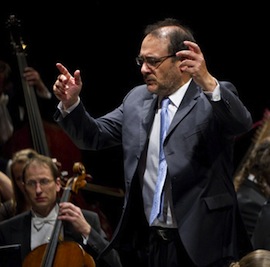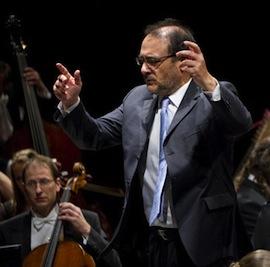
With the San Francisco Symphony’s Mavericks Festival right around the corner, Bay Area music lovers are eagerly anticipating 10 days of 20th-and 21st-century music. At Thursday afternoon’s concert in Davies Symphony Hall, however, the orchestra was firmly ensconced in the Classical era. On paper, the program of familiar works by Haydn and Mozart didn’t promise a particularly groundbreaking performance. Yet, with Rinaldo Alessandrini on the podium, making his San Francisco debut, the results were anything but staid.
Alessandrini, the founder of Concerto Italiano and principal guest conductor of the Norske National Opera in Oslo, is a forceful, dynamic leader, and Thursday’s concert, which repeats through Saturday evening, served as an impressive introduction to his skills. Pairing Haydn’s Symphony No. 104 in D Major, “London,” with Mozart’s Symphony No. 39 in E-flat Major, K. 543, and Piano Concerto No. 25 in C Major, K. 503, with pianist Olivier Cavé as soloist, the Italian maestro elicited vibrant performances in each work.
The orchestra certainly sounded energized in the opening performance of Haydn’s “London” Symphony. Completed in 1794-1795 as the final of two sets of six symphonies Haydn composed during his English residency, the score’s melodic invention and sonic richness never fail to impress. Absent from the S.F. Symphony’s repertoire since 2005, the work registered Thursday with an assertive, almost physical charge under Alessandrini’s direction.
The conductor gathered his forces in the brooding introduction, establishing firm tempos, pinpoint dynamics, and an unmistakable sense of portent. The first movement Allegro was stirringly dramatic; Alessandrini, a specialist in Italian Baroque opera, shaped the lyrical music with warmth, intensity and spaciousness. The strings produced wiry, well-defined sound; the horns were muscular, the woodwinds crisp and edgy.
Alessandrini didn’t sacrifice drama in the serene opening pages of the Andante, either. In the movement’s minor-key eruption, the conductor summoned Haydn’s darkening colors in subtle gradations. The brass section made baleful statements, and principal flutist Timothy Day contributed a lithe, agile solo.
The exuberant performance of the third movement Minuet was especially fine, with Alessandrini eliciting richly colored, enveloping sound; the conductor set an uncommonly brisk tempo for this music, yet it felt right, not rushed. The galloping finale can easily lapse into disarray, but Alessandrini delivered it in bracingly clear, articulate terms.
After intermission, Cavé joined the orchestra in Mozart’s Piano Concerto No. 25. The Swiss pianist, also making his S.F. Symphony debut this week, is a fleet, agile technician, and if his reading of the score occasionally sounded a bit measured against Alessandrini’s red-blooded approach, he still played with considerable musical intelligence and refinement. Cavé supplied plenty of sparkle in the outer movements; the finale, with its quote from Mozart’s Idomeneo, benefited from Alessandrini’s attention to detail. The conductor and his soloist had their finest moments in the graceful Andante, with Cavé giving a delicate, luminous performance over Alessandrini’s luxuriant orchestral backdrop. Again, the Symphony’s woodwinds excelled, their gentle give-and-take with the brass often achieving the Mozartean ideal.
The program concluded with Mozart’s Symphony No. 39, in a performance of great style and rhythmic vitality. Alessandrini achieved outstanding results in the third movement Minuet, with Day and principal clarinetist Carey Bell making easy work of the movement’s buoyant call-and-response effects. The go-for-broke finale yielded a rush of high spirits, bringing a very fine concert to a satisfying end. Thanks to Alessandrini, a program of warhorses yielded a performance to remember. The Bay Area’s music organizations should engage him for a return appearance as soon as possible.

